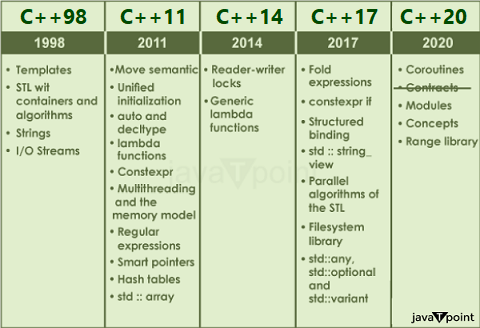Different versions of C++IntroductionC++, a versatile and powerful programming language, has undergone several developments since its inception in the late 1970s. C++ was created by Bjarne Stroustrup. It was created as an extension of the C programming language that incorporates object-oriented programming principles. Over the years, several versions of the language have been released, each containing new features and improvements and meeting the changing needs of the programming community. 
In this comprehensive study, we delve into the most important aspects of the various C++ versions from their early days to their most recent development. 1. C++98 (ISO/IEC 14882:1998):The first standard version of C++, C++98, was published in 1998. It laid the foundation for the language and introduced several key features that have become an integral part of C++ programming. Some of the most important aspects of C++98 are:
2. C++03 (ISO/IEC 14882:2003):C++03, published in 2003, was not a major revision of the language but rather a refinement and correction of problems found in C++98. The main features of C++03 are:
3. C++11 (ISO/IEC 14882:2011):C++11, published in 2011, was an important milestone in the development of the language. It introduced modern features and enhancements, ushering in a new era of C++ programming. The main features of C++ 11 are:
4. C++14 (ISO/IEC 14882:2014):C++14 was released in 2014, and it was an incremental update to C++11 that focused on refining and improving existing features rather than major new versions. The main parts of C++14 are:
5. C++17 (ISO/IEC 14882:2017):C++17 was released in 2017, and it continued to bring new features and improvements to the language. Notable features of C++17 include:
6. C++20 (ISO/IEC 14882:2020):C++20 was released in 2020, and it was a major update that brings significant additions and improvements to the language. The main features of C++20 are:
Conclusion:The development of C++ has been characterized by a series of standards, each of which brings new features, enhancements, and improvements to the programming language. Since its inception in the late 1970s, C++ has undergone several major updates, each version designed to address deficiencies, accommodate modern programming paradigms and adapt to the changing needs of software development. The journey started with C++98, the original standard version released in 1998. This version laid the foundation for the language and established the main principles and features. However, as the software development environment has evolved, the demand for more expressive and efficient programming tools has grown. This led to later versions that aimed to push the limits of C++. C++11, a milestone release in 2011, marked a turning point for the language. It introduced several features that significantly improved developers, #039, productivity, and code readability. Concepts such as the auto keyword, lambda expressions, and range-based for loops brought new expressiveness to C++, allowing programmers to write more compact and maintainable code. In addition, smart hints addressed memory management issues and promoted safer and more robust programming practices. Building on the success of C++11, C++14 focused on improving existing features rather than making groundbreaking changes. The goal of this release was to improve the language without breaking existing code bases, providing a smooth transition for developers and providing valuable improvements. Released in 2017, C++17 continued the trend of introducing impressive features. The file system library, parallel algorithms, and other enhancements aim to simplify common tasks and harness the power of modern device architectures. With C++17, the language further embraced modern development practices and made it easier to build powerful, scalable applications. The last major release of C++20 arrived in 2020 and has many features. Concepts and environments introduced more expressive type checking and manipulation, while routines simplified asynchronous programming. Among other things, these additions reflected the C++ community's continued commitment to providing developers with powerful tools for the demands of modern software development. In summary, the different versions of C++ represent a dynamic and iterative process of improvement and adaptation. Each version builds on the strengths of its predecessors, solves challenges, and includes valuable features for developers. Choosing a specific C++ version depends on factors such as project requirements, compiler support, and the need for the latest language features. As the language evolves, the legacy of each version adds to the rich body of C++'s history and its continued importance in the software world.
Next TopicFIFO Push Relabel Algorithm in C++
|
 For Videos Join Our Youtube Channel: Join Now
For Videos Join Our Youtube Channel: Join Now
Feedback
- Send your Feedback to [email protected]
Help Others, Please Share









